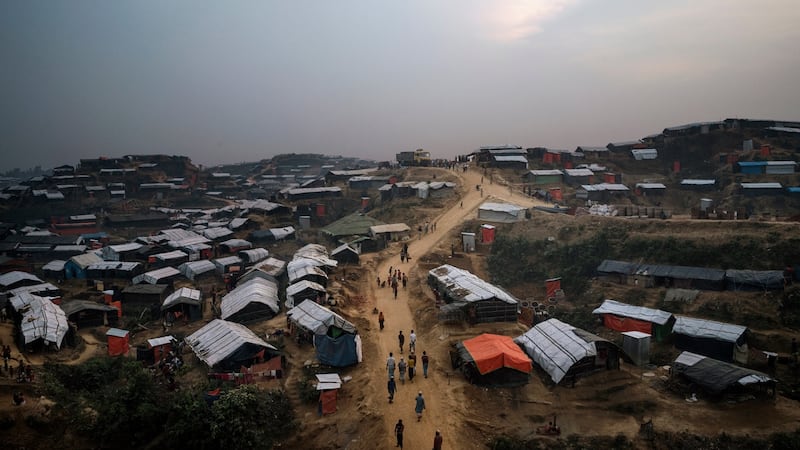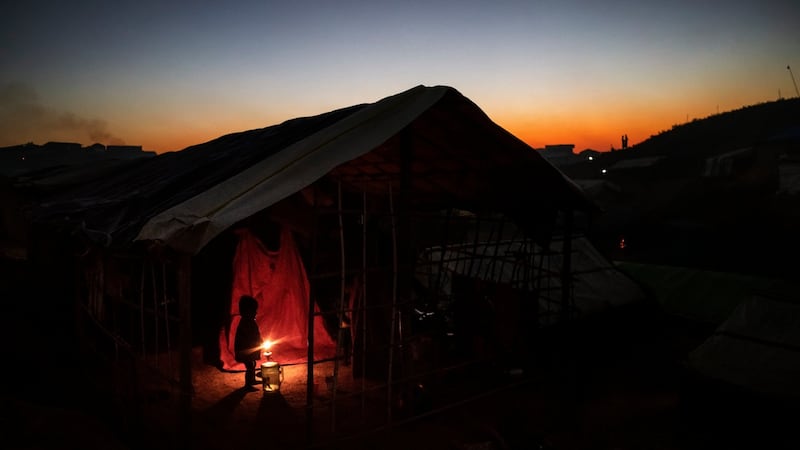The four young sisters sat in a huddle, together but alone. Their accounts were dramatic: their mother had died when their home was burned by soldiers in Rakhine state in western Myanmar. Their father was one of thousands of Rohingya Muslims who had disappeared into official custody and were feared dead.
Somehow, the sisters – ages 12, 8, 5 and 2 – made their way to refuge in Bangladesh. An uncle, who had been living for years in the Rohingya refugee camps in Bangladesh, had taken them in, adding the girls to his own collection of hungry children.
“My parents were killed in Myanmar,” said the eldest girl, Januka Begum. “I miss them very much.”
I was reporting on children who had arrived in the camps without their families. An international charity, which had given financial support to the uncle, brought me to meet the girls. Within an hour, I had a notebook filled with the kind of quotes that pull at heartstrings. Little of it was true.
After three days of reporting, the truth began to emerge. Soyud Hossain, the supposed uncle who had taken the girls in, was actually their father. He had three wives, two in Bangladesh and one in Myanmar, he admitted. The children were from his youngest wife, the one in Myanmar.
In any refugee camp, tragedy is commodified. Aid groups want to help the neediest cases, and people quickly realise that the story of four orphaned sisters holds more value than that of an intact family that merely lost all its possessions.
In any refugee camp, tragedy is commodified. Aid groups want to help the neediest cases
To compete for relief supplies distributed by aid groups, refugees learn to deploy women with infants in their arms. Crying babies get pushed to the front of the line. Such strategies are a natural survival tactic. Who wouldn’t do the same to feed a family?

But false narratives devalue the genuine horrors – murder, rape and mass burnings of villages – that have been inflicted upon the Rohingya by Myanmar’s security forces. And such embellished tales only buttress the Myanmar government’s contention that what is happening in Rakhine state is not ethnic cleansing, as the international community suggests, but trickery by foreign invaders.
Official narrative
The official narrative in Myanmar goes like this: Rohingya Muslims are illegal immigrants from an overcrowded Bangladesh. With Muslim men taking multiple wives, the Rohingya are reproducing faster than Myanmar’s majority Buddhists.
There is plenty of evidence to counter this claim. Muslim roots in the region reach back generations. The ratio of Muslims to Buddhists in northern Rakhine has not changed much over the past half-century. But with the Myanmar government restricting access to the area where the Rohingya once lived, even refusing to let top UN officials into the country, it is impossible for investigators and journalists to gather first-hand evidence of atrocities. Local reporters for Reuters who tried to investigate a mass grave now sit in jail.
That’s why in the refugee camps in Bangladesh, victims with physical manifestations of their trauma are simpler to interview. A fresh bullet wound in a child’s body is proof that something terrible happened. For every person quoted, I’d estimate that at least a dozen others were left in my notebooks. But a reporter’s necessary scepticism – which governs our work in every story – only contributes to the invasion of privacy. How must it feel for a Rohingya woman, who admits to a stranger that she was raped, when she realises that her story is being doubted?
Yet I have seen Rohingya people quoted in the foreign news media telling stories that I know are not true. Their accounts, in some cases, are too compelling, like a perfect storm of suffering. That is not to discount the collective trauma that has compelled nearly 700,000 Rohingya to flee for Bangladesh over the past five months. Médecins Sans Frontières estimates that 6,700 Rohingya met violent deaths in a single month last year. Even that number, the medical aid group says, is too low.
I have seen Rohingya people quoted in the foreign news media telling stories that I know are not true. That is not to discount the collective trauma that has compelled nearly 700,000 Rohingya to flee for Bangladesh
For four days, I interviewed a nine-year-old boy named Noorshad, and his story had it all. In my notebook, he drew pictures of his house – and the tree from which his parents were hanged by Myanmar soldiers. Then he drew the jerrycan he clung to as he crossed the river into Bangladesh. He tied his flip-flops to his waist, he said, with a bit of vine. The sandals were from his dead mother. He glanced at them and sobbed.
Inconsistent accounts
But there were inconsistencies. Noorshad said he liked cricket, a sport popular in Bangladesh but not in Myanmar. His grandparents were killed by the military, he told me, but then he admitted they had died of natural causes. I found locals from the village I believed he was from. It turned out that no one had been killed there, much less hanged from a tree.
So where did Noorshad come from? He had been found crying in the market in the Kutupalong refugee camp. Other refugees took him to a school where a pair of women offered hugs and bowls of curry. Obviously, something bad had happened to him, but to this day, no one has figured out his real story.
At times, there is a benign explanation for children telling untruths. Young minds can process lived memories and secondhand ones in remarkably similar ways.
"Even if some children have only heard of atrocities, fear has been instilled in them and it's very hard for them to separate what they've seen from what they've heard," said Benjamin Steinlechner, a spokesman for the UN Children's Fund in Cox's Bazar, Bangladesh. "It's like watching a horror movie. Children experience it very differently from adults."

I have a better sense of the life of Hossain, the four girls’ father. His troubles, he said, began when he was briefly back in Myanmar and saw a 12-year-old girl with fair skin and delicate features. “She was so beautiful,” Hossain said. “I needed to marry her.”
Child marriage is distressingly common among the Rohingya, and soon, Hossain began shuttling among his three wives. Not every wife knew about the other, but Hossain didn’t think three wives were too many. His own father, he said, had six wives and 42 children.
‘A bad man’
Yet Hossain admitted that he was not adept at balancing family relations. When his four daughters sought shelter in Bangladesh after their village had been burned, Sajida, the wife with whom he has been living in the Leda refugee camp, was furious.
“My husband is a bad man,” she announced, after she finally admitted the girls’ true provenance. “I am tired of all his lies.” Later, when I reached Hossain by phone, he was seething.
My husband is a bad man," she announced, after she finally admitted the girls' true provenance. "I am tired of all his lies
“I beat her when you left,” he said. “I will beat her again tomorrow.”
Hossain’s sister-in-law had also explained part of the family’s complicated truth. A neighbour later relayed that her candour had earned her a beating from her husband. Rather than highlight the plight of unaccompanied minors, my reporting had catalysed domestic violence in two households.
I regretted the days of questioning Sajida, who goes by one name. I had found her unsympathetic when she said she wished those girls would disappear back to Myanmar. But that night her husband would beat her. As I stood and judged her for not embracing these four girls from her husband’s youngest wife, a cockroach skittered across the floor. A rat followed.
Sajida began crying. All around, through the bamboo slats that make up the walls of a Rohingya shelter, children's eyes followed my movements, wondering what I was doing there and why I had made a grown woman weep. – New York Times










